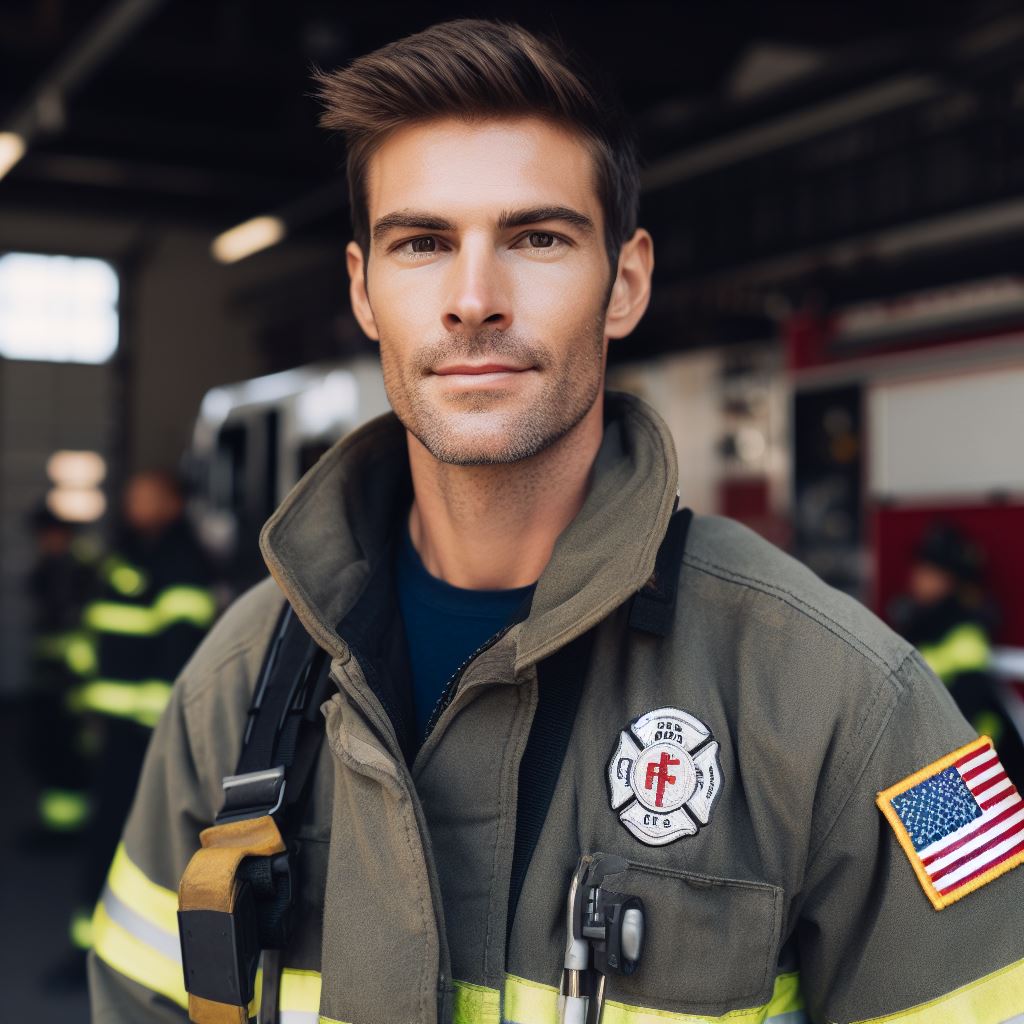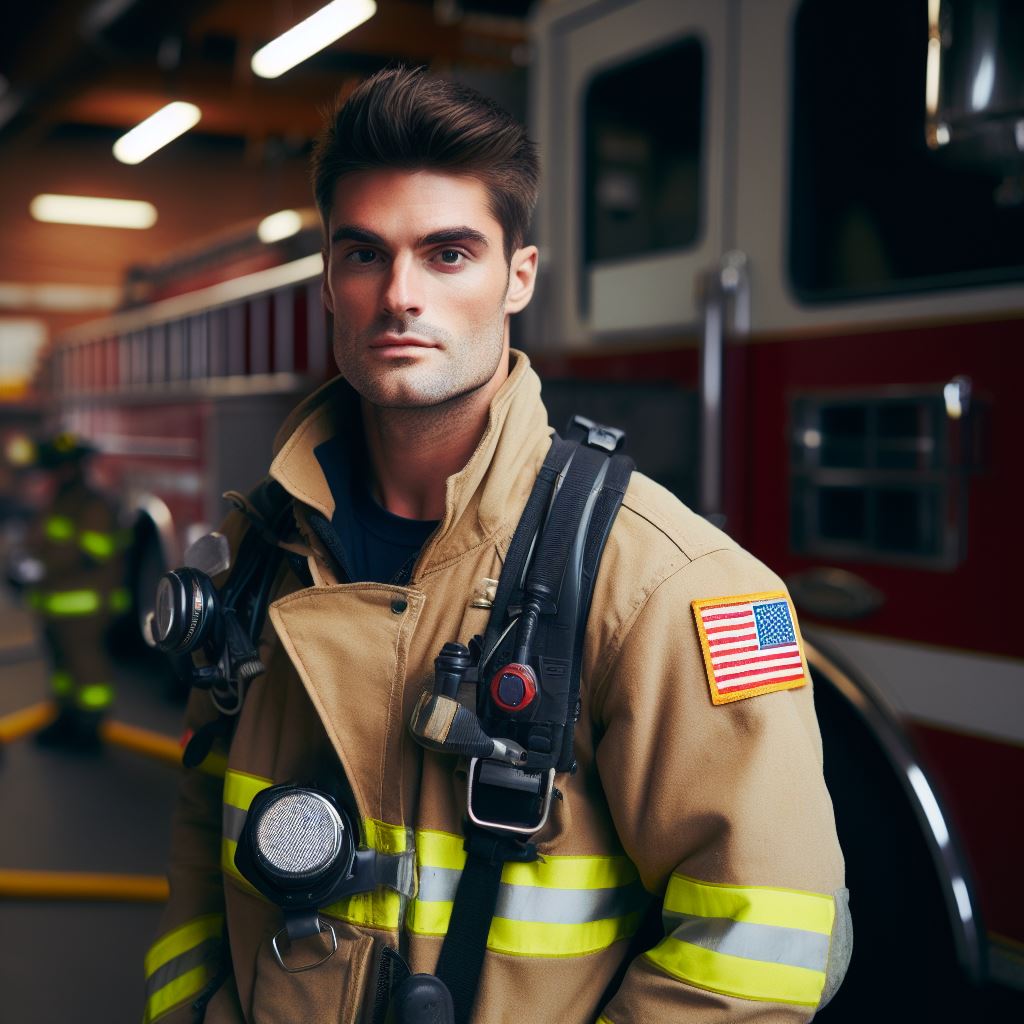Introduction
In the vibrant tapestry of U.S. cities, firefighters weave a narrative of courage, selflessness, and resilience.
Beyond the blaze of attention-grabbing emergencies, their roles intricately contribute to the safety and harmony of communities.
This post embarks on a journey to explore the profound significance and diverse responsibilities that define the firefighter’s landscape in American cities.
From the very beginning, let’s captivate your attention with a riveting statistic or anecdote that encapsulates the essence of a firefighter’s daily life and the challenges they bravely navigate.
As we unfold the layers of their responsibilities, you’ll discover that firefighters are not just responders to fires but versatile guardians, stepping into various roles that demand courage, skill, and compassion.
Furthermore, we’ll delve into the background of firefighting, offering insights into the evolution of their responsibilities and the ever-growing demands of modern urban landscapes.
The intricate tapestry of their work involves not only battling flames but also responding to medical emergencies, handling hazardous materials, and being the reassuring presence in various crises.
As we unfold this narrative, it becomes evident that appreciating the roles of firefighters extends beyond the surface, requiring an understanding of the challenges they face and the sacrifices they make.
By unraveling the layers of their contributions, this post aims to foster a profound admiration for the men and women who dedicate their lives to protect and serve in U.S. cities.
Fire Prevention and Education
Importance of fire prevention in reducing emergencies
- Fire prevention plays a crucial role in minimizing the occurrence of emergencies.
- It focuses on preventing fires from happening in the first place.
- Effective fire prevention measures can significantly reduce loss of life and property damage.
- By identifying potential fire hazards and taking preventive action, firefighters can save lives.
Fire education programs for communities
- Firefighters actively engage in educating communities about fire safety.
- They conduct fire education programs to raise awareness among individuals of all ages.
- These programs aim to teach people about fire hazards, evacuation procedures, and prevention techniques.
- By empowering communities with knowledge, firefighters contribute to a safer environment.
Organizing fire drills and training sessions
- Firefighters organize regular fire drills and training sessions in various settings.
- Practicing emergency procedures enables individuals to respond effectively in real situations.
- Fire drills improve the preparedness and efficiency of both community members and firefighters.
- Through these sessions, people become familiar with evacuation routes and learn how to use firefighting equipment.
Collaboration with schools, hospitals, and businesses
- Firefighters collaborate with schools, hospitals, and businesses to ensure fire safety.
- They assist in conducting inspections to identify potential fire risks in these establishments.
- Firefighters provide guidance on implementing safety measures to prevent emergencies.
- By working together, firefighters and these institutions create safer environments for everyone.
Most importantly, fire prevention and education form a vital part of firefighters’ roles in U.S. cities.
Emphasizing fire prevention, conducting educational programs, organizing drills, and collaborating with various entities, firefighters actively contribute to community safety and emergency reduction.
Emergency Response and Rescue
Prompt response to fire incidents
Firefighters are trained to provide quick and efficient responses to fire emergencies. They prioritize the safety of both the victims and themselves in these situations.
They rely on their training and expertise to assess the situation and determine the appropriate course of action.
Dispatchers play a crucial role in relaying information and making sure firefighters arrive at the scene promptly.
Fire suppression techniques and equipment used by firefighters
Firefighters employ a variety of techniques to extinguish fires and prevent them from spreading. They use water hoses, fire extinguishers, and chemical agents to combat different types of fires.
Firefighters undergo extensive training to understand the characteristics of different fires and the best methods to suppress them.
They rely on their knowledge of fire behavior and the properties of different materials to effectively control and extinguish the flames.
Safe evacuation procedures for victims
Ensuring the safe evacuation of individuals is a top priority for firefighters during fire incidents. They guide and assist victims in exiting the building using established evacuation routes.
In situations where smoke or flames block the main exits, firefighters utilize alternative escape routes.
They are trained to remain calm under pressure while helping victims to safety, even in dark and unfamiliar environments.
Rescuing individuals trapped in various settings
Firefighters are trained to rescue individuals trapped in a range of scenarios during fire emergencies. They use specialized tools and equipment, such as ladders and ropes, to access victims in high-rise buildings.
In situations where victims are trapped in confined spaces, firefighters employ techniques like breaking through walls or using hydraulic tools.
They work swiftly and effectively to free trapped individuals and ensure their well-being.
Collaboration with medical personnel and other emergency services
Firefighters frequently collaborate with medical personnel and other emergency services to provide comprehensive assistance.
In medical emergencies, they provide initial first aid and coordinate with paramedics for further medical interventions.
Additionally, firefighters work alongside law enforcement agencies to ensure public safety during emergencies.
This collaboration allows for a well-coordinated response to incidents and enhances the overall effectiveness of emergency services.
In review, the roles of firefighters in U.S. cities extend beyond firefighting.
Their prompt response, utilization of fire suppression techniques, and safe evacuation procedures are crucial in preventing loss of life and property.
Their expertise in rescuing individuals trapped in various settings and collaboration with other emergency services enhance public safety.
Through their dedication and training, firefighters play a critical role in emergency response and rescue operations.
Read: Post-Traumatic Stress Disorder (PTSD) in Military Vets
Hazardous Material Management
Firefighters play a crucial role in managing hazardous materials in U.S. cities. They are trained extensively in handling and containing hazardous substances to minimize risks and protect communities.
Handling and containment of hazardous substances
Firefighters are trained to safely handle and contain hazardous substances such as chemicals, gases, and radioactive materials.
They use specialized equipment and follow strict protocols to prevent exposure and ensure public safety.
Knowledge of different types of hazardous materials
Firefighters must have a comprehensive understanding of various types of hazardous materials.
This knowledge allows them to assess risks, implement appropriate strategies, and communicate effectively with other emergency responders.
Protective gear and specialized training
Firefighters are equipped with protective gear specifically designed for hazardous material incidents. This includes hazmat suits, respirators, gloves, and boots.
They undergo specialized training to use this equipment effectively while minimizing personal exposure.
Importance of preventing and managing chemical spills
Chemical spills can have severe consequences for both human health and the environment. Firefighters play a critical role in preventing and managing these spills.
They are trained in containment techniques, decontamination procedures, and implementing evacuation plans.
When a hazardous material incident occurs, firefighters are among the first responders. They assess the situation, identify the materials involved, and initiate appropriate actions to mitigate risks.
Their primary goal is to protect lives, property, and the environment.
Firefighters use their knowledge of hazardous materials to determine the best approach for each incident.
They collaborate with other agencies, such as environmental protection agencies and hazardous materials teams, to develop effective response plans.
Once on the scene, firefighters establish a command center and coordinate efforts with other emergency responders.
They work in a systematic manner, following established protocols to safely contain and neutralize the hazardous materials.
Transform Your Career Today
Unlock a personalized career strategy that drives real results. Get tailored advice and a roadmap designed just for you.
Start NowThe use of protective gear is crucial during hazardous material incidents. Firefighters wear hazmat suits, respirators, and other necessary equipment to protect themselves from exposure.
This allows them to safely approach and handle the hazardous materials without endangering their own health.
The specialized training that firefighters undergo prepares them for the challenges of managing hazardous materials.
They learn about the properties, risks, and proper handling procedures for different types of hazardous substances.
This knowledge enables them to make informed decisions and take appropriate actions during incidents.
Preventing and managing chemical spills is a top priority for firefighters. They are trained to contain spills as quickly as possible to prevent further contamination and harm.
They utilize various techniques, such as creating barriers and using absorbent materials, to limit the spread of hazardous substances.
In short, firefighters have a crucial role in hazardous material management in U.S. cities.
Their expertise in handling and containing hazardous substances, knowledge of different types of materials, use of protective gear, and specialized training make them essential contributors to public safety.
By preventing and managing chemical spills, firefighters protect lives, property, and the environment, ensuring the well-being of communities they serve.
Read: The Role of the U.S. Coast Guard: Beyond Sea Rescues
Medical Assistance and First Aid
First responders in medical emergencies
- Firefighters play a crucial role as first responders in medical emergencies.
- They are often the first on the scene to provide immediate medical assistance.
- Their quick response can potentially save lives and minimize further injuries.
- They assess the situation and stabilize patients until paramedics arrive.
CPR and basic life support provided by firefighters
- Firefighters are trained in CPR (Cardiopulmonary Resuscitation) and basic life support techniques.
- They are skilled in performing chest compressions and rescue breathing.
- These skills are vital in cases of cardiac arrest or respiratory emergencies.
- By initiating CPR, firefighters can help maintain blood circulation and oxygen supply to the body.
Administering oxygen and controlling bleeding
- Firefighters are equipped with oxygen delivery systems to assist patients with breathing difficulties.
- They can administer oxygen to stabilize individuals until professional medical help arrives.
- In emergency situations involving severe bleeding, firefighters are trained to control and minimize blood loss.
- They use appropriate measures such as applying pressure or using tourniquets to stop bleeding.
Assisting paramedics and EMTs
- Firefighters work closely with paramedics and Emergency Medical Technicians (EMTs) during medical emergencies.
- They provide valuable support by assisting in patient transport and loading them into ambulances.
- Firefighters help EMTs in performing medical procedures and ensuring the safety and well-being of patients.
- Their teamwork with paramedics and EMTs enhances the overall efficiency of emergency medical services.
Medical assistance and first aid are significant aspects of a firefighter’s role in U.S. cities. They serve as first responders, providing immediate medical assistance in emergencies, including CPR and basic life support.
Firefighters also administer oxygen and control bleeding, ensuring patients’ stability until paramedics arrive.
Their collaboration with paramedics and EMTs further contributes to the effective delivery of emergency medical services.
Read: Financial Planning for U.S. Military Personnel & Families

Uncover the Details: Finding the Best Security Guard Training Programs Across the U.S.
Public Safety and Public Relations
Ensuring public safety during emergencies
- Responding promptly to emergency calls and providing aid to those in need.
- Performing search and rescue operations to ensure everyone’s safety.
- Extinguishing fires and preventing further damage to property and people.
- Coordinating with other emergency response departments to provide comprehensive assistance.
- Implementing safety protocols to minimize risks and protect the public.
Community outreach programs and initiatives
- Organizing fire safety workshops and demonstrations to educate the public on preventive measures.
- Creating partnerships with local organizations to raise awareness about fire hazards.
- Establishing relationships with schools to teach children about fire safety.
- Participating in community events to engage with residents and address their concerns.
- Collaborating with neighborhood associations to develop emergency preparedness plans.
Fire safety inspections and code enforcement
- Conducting routine inspections of buildings to ensure compliance with fire safety regulations.
- Identifying potential fire hazards and recommending corrective actions to property owners.
- Enforcing fire codes and regulations to prevent the occurrence of preventable incidents.
- Educating building owners and managers about fire safety standards and best practices.
- Working closely with local authorities to enforce regulations and maintain public safety levels.
Assisting with community events and public education campaigns
- Collaborating with local organizations to host fire safety events and public education campaigns.
- Providing interactive demonstrations on safety procedures and equipment handling.
- Engaging with the community by offering tours of fire stations and fire trucks.
- Participating in school visits to educate children about fire prevention and emergency procedures.
- Supporting public health initiatives by promoting smoke alarm installations and fire escape plans.
In essence, firefighters play diverse and essential roles in ensuring public safety and maintaining positive public relations within U.S. cities.
They go beyond responding to emergencies and also work actively to prevent incidents through community outreach programs, fire safety inspections, and code enforcement.
Their constant involvement in various community events and public education campaigns strengthens their relationships with residents and creates a culture of preparedness and prevention.
By understanding and appreciating the multifaceted roles of firefighters, we can acknowledge their significant contributions to keeping our cities safe.
Read: Adapting to Civilian Life: Tips for Returning Veterans
Learn More: U.S. Security Guard Licensing: Steps and Requirements Explained
Explore Further: The Evolution of Policing in America: A History
Conclusion
Roles and responsibilities of firefighters in U.S. cities.
In the end, firefighters in U.S. cities play crucial roles in ensuring the safety and well-being of their communities.
They are responsible for extinguishing fires, rescuing individuals in emergency situations, and providing medical aid when needed.
Additionally, they conduct regular inspections to ensure buildings adhere to fire safety codes.
It is essential that we appreciate and support these brave men and women who put their lives on the line to protect us.
Through their selflessness and dedication, they ensure that our cities remain safe places to live and work in.
Understanding the roles and contributions of firefighters allows us to have a deeper appreciation for the challenges they face on a daily basis.
By recognizing their importance, we can advocate for the necessary resources, funding, and training they need to continue their vital work.
It is our collective responsibility to support and thank our firefighters for their unwavering commitment to our communities.
Let us never forget the sacrifices and bravery of these heroes who work tirelessly to keep us safe.
Next time you see a firefighter, take a moment to express your gratitude and let them know how much their service means to you.
Together, we can ensure that firefighters have the support they deserve and continue to make a difference in the lives of countless individuals.
[E-Books for Sale]
The Big Book of 500 High-Paying Jobs in America: Unlock Your Earning Potential
$19.99 • 500 High-Paying Jobs • 330 pages
Explore 500 high-paying jobs in America and learn how to boost your career, earn more, and achieve success!
See All 500 High-Paying Jobs of this E-Book
1001 Professions Without a Degree: High-Paying American Jobs You Can Start Now
$19.99 • 1001 Professions Without a Degree • 174 pages
Discover 1001 high-paying jobs without a degree! Unlock career tips, skills, and success strategies for just $19.99!




